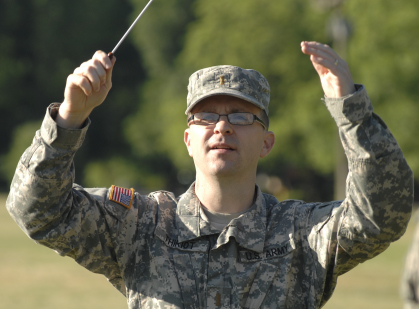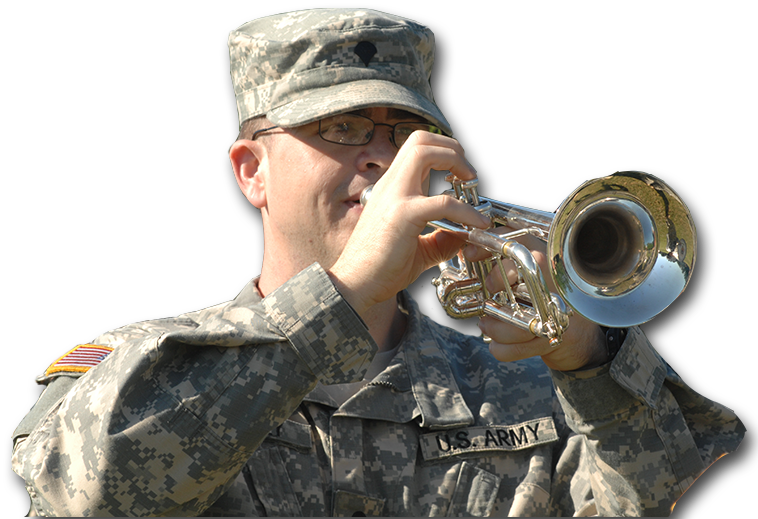For centuries military bands have lent dignity and art to what might otherwise be droll affairs. Medieval Turks have been credited with developing the first truly military bands. Western Europe followed suits and the British military bands provided the model for the first American military band formed as a part of the Marine Corps by act of Congress in 1798.

The Army soon formed its first bands organized to support militia units as the strength of the regular U.S. Army at the close of the 18th century was less than 200 soldiers.
During the Civil War each regiment was required to organize a field band; generally a dozen or so musicians playing primarily bugles, fifes, and drums. The prime purpose of these early bands was command and control of tactical units by either beating or sounding movements and tactical operations through specific tunes.
These early field bands quickly became excellent morale boosters and began performing concerts and recitals not only for soldiers but also for surrounding communities. General George Armstrong Custer is known to have used the Seventh Cavalry band to play during actual combat operations to inspire his troopers. New York Mayor Fiorello La Guardia was raised on a diet of martial music as his father, Sergeant Achille La Guardia, directed the 6th Infantry band during the latter Indian Wars, in Arizona Territory.
World War I saw a change in tactics as well as the development of wire communications. Military bands were no long so concerned with maneuver and tactical movements. They adapted their instrumentation to support drill and ceremonies such as Sunday parades and evening concerts. The drum and bugle gave way to keyed trumpets and saxhorns-forerunner to modern brass and woodwind instruments.
The 63rd Regional Support Command is privileged to exercise command and control over three U.S. Army Reserve Field Bands; the 191st Army Band, Dublin, California; the 300 Army Band, Bell, California and the 395thArmy Band; Mustang, Oklahoma. Their histories are as varied as their locations.

191st Army Band was initially constituted on 2 august, 1943 organic to the 91st Infantry Division that would see action in World War II in the European theater of Operations. After VE day the 191st was headquartered at Camp White, Oregon; Camp Rucker, Alabama, San Francisco and Sausalito, California. Since the year 2000 the 191sthas called Dublin, California home. It proudly refers to itself as “the Band of the wild West.” It was the only military band deployed during Operation Iraqi Freedom and Operation Enduring Freedom.
The 300th Army Band is southern California’s only Army Reserve Band and dubs itself, “Hollywood’s Own.” It travels from coast to coast performing in a wide range of ceremonies, concerts and school assemblies. During the Second World War, the 300 was activated in London, England as the 300th Army Ground Forces Band and supported operations throughout Europe until being inactivated in Germany in 1946.
The organization now known as the 300th Army Band was reactivated in May of 1947 and became part of the U.S. Army Reserve family in 1968. As Reservists the band performs throughout the Southwest United States. It has also supported operations at Fort Carson, Colorado; Fort Cambell, Kentucky, Fort Sam Houston, Texas; and Fort Riley, Kansas. It was also one of two Army Reserve bands selected to provide musical support for Operation New Horizons in El Salvador and Panama. They have also performed for President Gerald Ford. In keeping with their Hollywood moniker they have also entertained Governor Arnold Schwartzenegger, John Voight, Gary Sinise and William Shatner.
The 395th Army Band dates back to 2 August 1943 when it was constituted in the Organized Reserves for the 95th Infantry Division, the “Ironmen of Metz” recognizing their military achievements in the liberation of Metz, France, during World War II. Making its home in Mustang, Oklahoma, the 395th provides musical support to the seven states in the Southwest Region including Arkansas, Oklahoma, Texas, New Mexico, Arizona, Nevada and California. It has been a part of the 63rd Regional Support command since October 2009.

Soldier-musicians in army bands must meet all requirements for enlistment in the U.S. Army. Once mustered they must complete basic training designed to impart basic soldierly skills and Advanced Individual Training at the Army School of Music on Norfolk, Virginia.
Army band members are first and foremost-soldiers and must maintain war-fighting skills including weapons qualifications, physical fitness and first aid. Their heritage is proud, diversified and talented.
(Historical Article by Robert R. Rybolt, 63d RSC Historian)